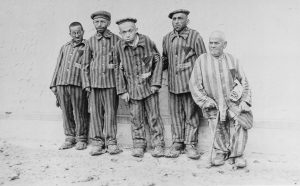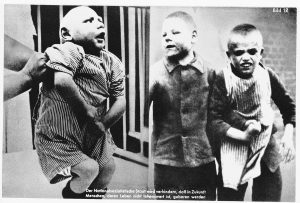Part 2A: The Murder of Children and the Developmentally Disabled

Developmentally disabled Jewish prisoners, photographed for propaganda purposes, who arrived in the Buchenwald concentration camp in Germany after Kristallnacht, 1938. Photo credit: USHMM #13132, courtesy of Robert A. Schmuhl
The Nazis considered people with disabilities to be “useless eaters” and a burden on the Aryan race. In order to purify German society, Hitler authorized the secret killing of psychiatric patients beginning in October 1939. The Nazi Euthanasia Program became known as Aktion T4 (named after the coordinating Chancellery office at Tiergartenstrasse 4 in Berlin) and marked Nazi Germany’s first campaign of mass murder. T4 initially targeted developmentally disabled infants and toddlers in Germany, but later included adults with disabilities all across Europe.

Nazi propaganda composite photograph showing developmentally disabled German children. The caption reads, “The National Socialist State in the future will prevent people whose lives are not worth living from being born,” circa 1933-1943. Photo credit: USHMM #62928
German doctors and nurses played key roles, killing 250,000 people in a program that was euphemistically labeled as euthanasia. Many of these murders occurred even after Hitler publicly suspended the operation in August 1941. Physicians evaluated patients in asylums, hospitals, and nursing homes where anyone deemed unable to work or harmful to German society was taken to remote killing stations. Many were murdered in specially constructed gas chambers, while others were killed by lethal injection and systematic starvation. In Nazi-occupied Eastern Europe, thousands of people with psychiatric illnesses were killed on the spot by Nazi police. Many officials and functionaries involved in the euthanasia program later helped carry out the larger genocide of European Jewry.